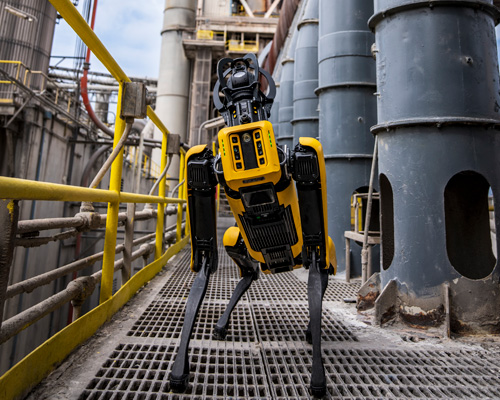Ash Grove Cement, A CRH company, has employed the help of an autonomous robot in a year-long pilot, to boost efficiency and safety during site inspections.
The four-legged, futuristic robodog, named ‘Spot’, performs proactive inspection routines repetitively, with acute precision. This sophisticated robot can operate in hot and dusty conditions, improving safety and freeing up skilled teams to solve complex issues elsewhere on site.
Ash Grove has deployed its robo-dog, developed by cutting-edge robotics engineers, to improve site safety across its cement plant in Washington State. The autonomous robot navigates the plant’s complex and often hazardous environment, collecting data through real-time monitoring, in a move that’s set to revolutionize manufacturing, and offer unparalleled efficiency.
A game-changer for safety, reducing the need for humans to operate in hazardous environments
This nimble, state-of-the-art machine is capable of navigating treacherous industrial terrain, taking on hazardous tasks, while its human counterparts stay safely at a distance. For example, at Ash Grove Cement, Spot uses laser scanning to take brick measurements inside the kiln, eliminating potential safety incidents amongst the workforce.

Spot allows tasks to be completed faster and more accurately than manual labor
And Spot doesn’t get tired! The robot can perform mundane but critical, proactive inspection routines repetitively for more than 80 hours a week. Spot is equipped with a wide range of sensors and a 360-degree 4k camera. It can read, assess, and report on site and equipment issues more precisely and consistently than a human, leading to a more reliable proactive maintenance program. This frees up skilled maintenance teams to solve complex issues elsewhere on the site while reducing the risk of human error and fatigue.
Preventing costly failures and downtime through precise, real-time monitoring
In the early stages of the trial, the robot was able to detect a failing bearing in part of the site’s rotating equipment, which might have eventually led to unplanned downtime. This eliminates unnecessary downtime, decreases manufacturing site costs and drives profitability. Meanwhile, the data collected can be used to better enhance the overall efficiency of critical assets and maximize their uptime.
In all, the pilot program has delivered more accurate data, fewer shutdowns, and a safer workplace – all thanks to a four-legged tech hero.